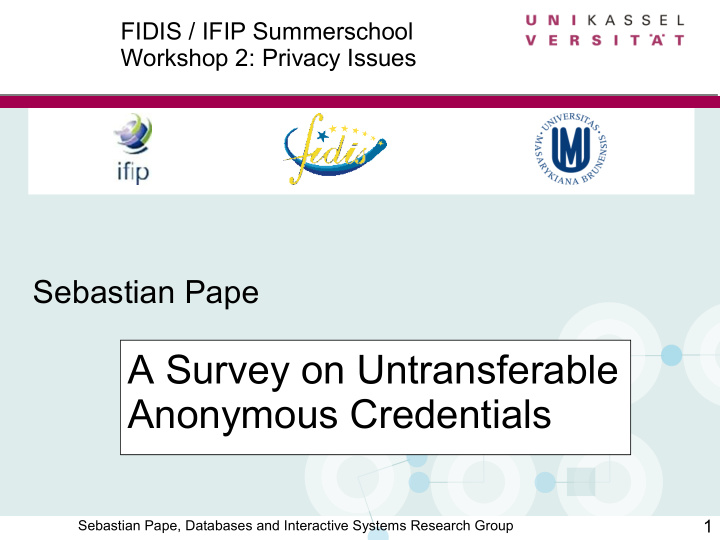



FIDIS / IFIP Summerschool Workshop 2: Privacy Issues Sebastian Pape A Survey on Untransferable Anonymous Credentials 1 Sebastian Pape, Databases and Interactive Systems Research Group
Overview ● Anonymous Credentials ● Approaches to ensure untransferability ● System's Security ● Attacks ● Comparison / Conclusion 2 Sebastian Pape, Databases and Interactive Systems Research Group
Anonymous Credentials ● Introduced by Chaum ● Consist of cryptographic tokens (ZKP, Blind/Group Signature) ● Allow authentication without identification ● Related to anonymous payment ● But non-transferablity may be wished ● age verification ● driving license ● student ID ● ... ● How can you be sure the token was used by its regular owner? 3 Sebastian Pape, Databases and Interactive Systems Research Group
Approaches ● Two different approaches ⇒ Make the user not wanting to share ● Embed valuable secrets into the system ⇒ Keep tokens secret from user ● Use of Biometrics ● Advantages / Disadvantages? 4 Sebastian Pape, Databases and Interactive Systems Research Group
Embedded Secrets ● Discourage users to share credentials ● Sharing a credential shares a valuable secret ● User's credential is made valuable beyond primary intent ● Assumption/Hope: User won't share credentials ● Interactive Protocol for Credential issuing ● Keeps embedded secret ● May be tough to verify the secret's accuracy 5 Sebastian Pape, Databases and Interactive Systems Research Group
Embedded Secrets ● Embed secret from outside the system ● By Lysyanskaya / Rivest / Sahai / Wolf ● PKI-assured non transferability ● Valuable Master key ● To sign legal/financial documents ● Connect all credentials in the system ● Camenisch / Lysyanskaya ● All-or-nothing transferability 6 Sebastian Pape, Databases and Interactive Systems Research Group
Hardware (S) Wallet Verifier ● User is able to check information flow ● Observer not needed 7 Sebastian Pape, Databases and Interactive Systems Research Group
AC with Biometrics ● Access control by biometrics ● Authentication factor "knowledge" transformed to "possesion" ● Smartcard works as Blackbox for the user ● General biometric problems apply 8 Sebastian Pape, Databases and Interactive Systems Research Group
Wallet-with-Observer Wallet Observer Verifier ● Suggested by Chaum and Pedersen ● User is able to check information flow ● Organisation has to trust observer 9 Sebastian Pape, Databases and Interactive Systems Research Group
Biometrics (Hardware) Source: www.fidelica.com ● No template database ● Match-on-card system ● Protected against eavesdropper 10 Sebastian Pape, Databases and Interactive Systems Research Group
Wallet-with-Observer (B) Wallet Observer Verifier ● Extension by Bleumer ● Biometrics to Observer ● User is able to check information flow ● Organisation has to trust observer 11 Sebastian Pape, Databases and Interactive Systems Research Group
System's Security (G) Security of the basis credential system (B) Security of untransferability by biometric access control (S) Security of untransferability by embedding a valuable secret 12 Sebastian Pape, Databases and Interactive Systems Research Group
System's Security (G1) Security of cryptographic functions (G2) Credentials' secrecy (initialization) (B1) Quality of tamperproofness (B2) Difficulty duping biometric sensors (S1) Value of embedded secret (S2) Precautions to prevent misuse (S3) Connection of credential & secret 13 Sebastian Pape, Databases and Interactive Systems Research Group
Scenario ● Issuer creates credential in regard to biometrics / secret ● Verifier has interest to check credential – Discount (student / handicapped ID) – Enforcement of laws (tobaco, driving) ● Untransferability is not in the user's interest 14 Sebastian Pape, Databases and Interactive Systems Research Group
Attacker Model ● Main focus: – Comparison regarding untransferability ● Assumptions: – No high-security environment ● Practical view on security – 3rd parties have less power than involved p. – All parties use trusted hardware – Tamperproof device chosen by Issuer/Verifier 15 Sebastian Pape, Databases and Interactive Systems Research Group
Attacker Model ● Verifier/Issuer wants to gather information – Wallet-with-observer architecture holds ● Issuer does not leak/get information – e.g. credentials, biometrics, embedded secret ● => User is a possible attacker – Untransferability is on the user's part 16 Sebastian Pape, Databases and Interactive Systems Research Group
Attacks (G) (G1) Security of cryptographic functions (G2) Credentials' secrecy (initialization) ● Apply to both approaches ● Assumed to be safe ● General problem with Wallet-with-Observer 17 Sebastian Pape, Databases and Interactive Systems Research Group
Wallet-with-Observer Architecture Observer Wallet Verifier ● General Problem: Contact to "correct card"? 18 Sebastian Pape, Databases and Interactive Systems Research Group
Attacks (B) (B1) Quality of tamperproofness (B2) Difficulty duping biometric sensors ● Biometric device embedded in Smartcard – Otherwise privacy-risk (cash cards) ● Moderately secure biometric sensor ● Attended or unattended control ? 19 Sebastian Pape, Databases and Interactive Systems Research Group
Attacks (S) (S1) Value of embedded secret (S2) Precautions to prevent misuse (S3) Connection of credential & secret ● Precautions depend on value of secret – User acceptance ● Detaching credentials unfeasible ● Value of secret most important 20 Sebastian Pape, Databases and Interactive Systems Research Group
Attacks (B vs. S) (B2) Difficulty duping biometric sensors ● Control depends on (un)attendance ● Expensive, not universal, error-prone? (S1) Value of embedded secret ● Which secret to use? ● Secret is able to protect lower values ● Raises system's value 21 Sebastian Pape, Databases and Interactive Systems Research Group
Conclusion ● ● (un)attended AC ● Secret Circumvention ● ● Biometrics ● Secret Universality ● ● Tamperproof + ● Not needed Special device ● biometric reader ● Unlikely ● May occur Unint. Sharing ● ● Unchanged ● Raised System's Value ● 22 Sebastian Pape, Databases and Interactive Systems Research Group
Conclusion ● Secret - (un)attended AC Circumvention ● Biometrics ● Secret Universality - Tamperproof + + Not needed Special device biometric reader + Unlikely - May occur Unint. Sharing + Unchanged - Raised System's Value 23 Sebastian Pape, Databases and Interactive Systems Research Group
Recommend
More recommend